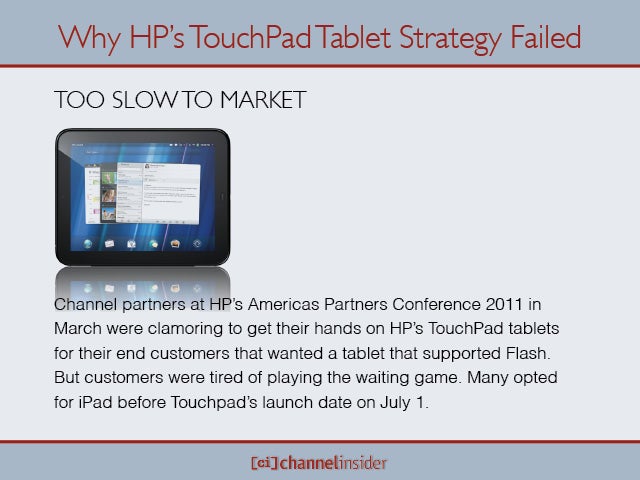 Why HP’s TouchPad Tablet Strategy Failed
Why HP’s TouchPad Tablet Strategy Failed
Too Slow to MarketChannel partners at HP’s Americas Partners Conference 2011 in March were clamoring to get their hands on HP’s TouchPad tablets for their end customers that wanted a tablet that supported Flash. But customers were tired of playing the waiting game. Many opted for iPad before Touchpad’s launch date on July 1.
 No Title
No Title
Too Few AppsWhile Apple’s App Store and the Android Marketplace claimed hundreds of thousands of apps, WebOS only had 6,000 to start with.
 No Title
No Title
More of the SameA quick view of the tablet market shows iPad in the lead with a host of other tablets trying to catch up. TouchPad was one of the crowd and HP had not effectively demonstrated to potential buyers why their device was better than any of the others.
 No Title
No Title
No 3G/4G Support at LaunchHP promised that later versions of the device would support 3G and 4G but the first generation supported only Wi-Fi, a limitation when pitted against other tablets.
 No Title
No Title
No Support for Storage CardsPromoted as a security feature, HP made the decision to not support external storage cards. There are no slots. That left users hitting just 16Gb or 32Gb of internal memory – not very much.
 No Title
No Title
Inadequate Promotion HP’s integration of its webOS phone with its webOS TouchPad tablet provided some pretty nifty features. For instance, a user could touch one device to the other to share a web page. But the features were not widely promoted. Indeed, while there are plenty of walking advertisements for iPad, HP did not put enough marketing muscle behind its tablet launch.
 No Title
No Title
Exclusive Software RelationshipsTouchPad shipped with Kindle preinstalled and Citrix supported, but the company said it did not plan to initially support either VMware’s desktop virtualization or other eBook formats. That was likely at turn off for buyers who preferred the other software.
 No Title
No Title
High CostsElectronics analyst firm iSuppli estimated that it cost HP $306.65 to make each TouchPad, not including the $1.2 billion HP plunked down to acquire Palm and the webOS in the first place. That’s a big investment to have been made.
 No Title
No Title
Pricing Too HighWith the market leader, iPad starting at $499, HP was foolish to price its TouchPad comparably. iPad had already established itself as the device to beat on functionality, style and price. It didn’t have better functionality or style. Price was its only option.
 No Title
No Title
Pricing, AgainBut once HP dropped the price to $99 for the entry-level model, the TouchPad flew off the shelves. Days later it was out of stock everywhere. Tech publications were running articles on “what to do with your $100 TouchPad” (i.e. It’s cheaper than a Kindle, and it has a Kindle app. Or, program it with kids’ sites and give it to your kid.)

